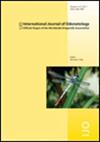哥伦比亚安第斯地区生态系统中尖齿齿齿蛛的种群特征和行为
IF 1
4区 农林科学
Q3 ENTOMOLOGY
引用次数: 0
摘要
在哥伦比亚安第斯地区北桑坦德省的三条低地溪流上研究了Hetaerina cruenta的人口学和领土行为。成年豆娘(N:278)被单独标记,利用它们的捕获历史,我们估计了每个地点的存活率、寿命、性别比、年龄组和种群规模。我们没有发现年龄和性别之间存在生存差异的证据。然而,女性被封为贵族的比例较低,所有人群的性别比都偏向男性。尽管我们记录的生殖事件很少,但在中午左右记录到了大量的雄性-雄性痛苦互动。在生殖行为过程中,我们观察到雄性和雌性之间短暂的翅膀显示,以及串联位置的形成,然后是雄性内精子易位和交配(平均持续时间11.3分钟)。交配后,这对雌蛛串联寻找合适的产卵地点,然后雄蛛打破串联,栖息在植被上,而雌蛛则部分或完全在水下产卵。重新捕获的概率是与时间相关的,这表明研究期间雨天和晴天的交替可能会导致三个红齿藻种群的人口学差异。本文章由计算机程序翻译,如有差异,请以英文原文为准。
Demographic Traits and Behavior of Hetaerina cruentata (Odonata: Calopterygidae) in Ecosystems of the Andean Region of Colombia
Demography and territorial behavior of Hetaerina cruentata was studied along three lowland streams located at Norte de Santander department in the Colombian Andean region. Adult damselflies (N: 278) were individually marked, and using their recapture histories we estimated survival, longevity, sex ratio, age groups and population size at each location. We found no evidence for survival differences between ages and sexes. However, the proportion of resighted individuals was lower for females, and the sex ratio was male-biased in all populations. Although we recorded few reproductive events, a high number of male-male agonistic interactions were registered around midday. During reproductive behavior, we observed brief wing displays as signals between males and females, and the formation of the tandem position, followed by the intra-male sperm translocation and copulation (mean duration 11.3 min). After copulation, the pair in tandem looked for suitable sites to oviposit, and then the male broke tandem and perched on the vegetation while the female laid eggs partially or completely underwater. The recapture probability was time-dependent, which suggests that the alternation of rainy and sunny days during the study may be generating differences in the demography of the three H. cruentata populations.
求助全文
通过发布文献求助,成功后即可免费获取论文全文。
去求助
来源期刊

International Journal of Odonatology
ENTOMOLOGY-
CiteScore
2.30
自引率
0.00%
发文量
15
审稿时长
>12 weeks
期刊介绍:
International Journal of Odonatology (IJO) is aimed at providing a publication outlet for the growing number of students of Odonata. It will address subjects such as the ecology, ethology, physiology, genetics, taxonomy, phylogeny and geographic distribution of species. Reviews will be by invitation, but authors who plan to write a review on a subject of interest to the journal are encouraged to contact the editor.
 求助内容:
求助内容: 应助结果提醒方式:
应助结果提醒方式:


